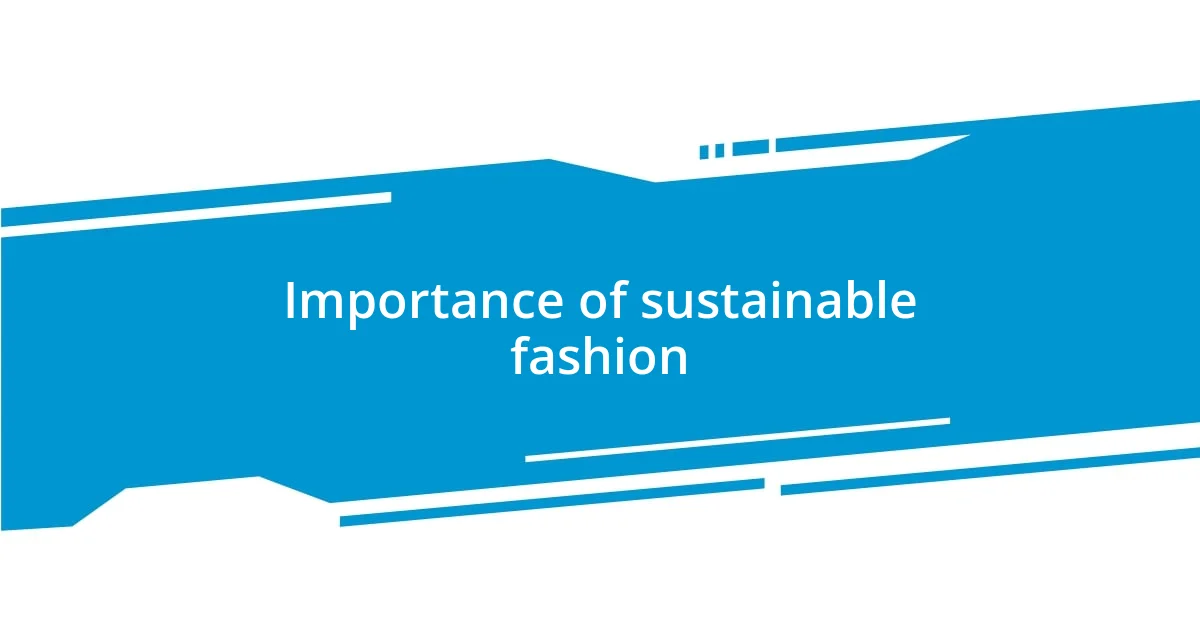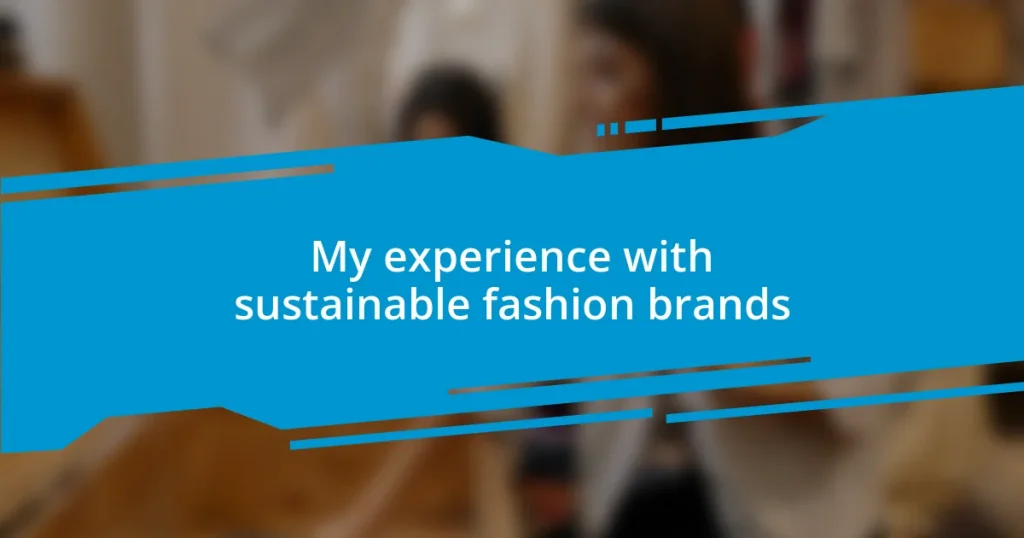Key takeaways:
- Sustainable fashion brands prioritize ethical practices, transparency, and environmental responsibility, influencing consumers to support positive change through their purchasing choices.
- Challenges such as high prices, consumer awareness, and the pervasive influence of fast fashion impede the growth of sustainable fashion, highlighting the need for increased accessibility and education.
- The future of sustainable fashion looks promising with innovations like blockchain for transparency, collaborations to strengthen local economies, and a shift towards a circular model to reduce waste.

Understanding sustainable fashion brands
Sustainable fashion brands prioritize ethical practices and environmental responsibility in their production processes. I remember the first time I discovered a brand that used organic cotton and recycled materials – it felt like a revelation. I had always loved fashion, but suddenly, I realized I could support a style that values the planet and its people.
When I think about what defines a sustainable fashion brand, it goes beyond just materials. It encompasses fair labor practices, transparency in the supply chain, and the overall impact on the environment. Have you ever considered how the clothes you wear affect the world around you? It gives me pause, knowing that each purchase can either contribute to environmental degradation or support brands striving for positive change.
As I began researching more about these brands, I was struck by the stories behind them. Many are started by passionate individuals aiming to make a difference, often sharing their journey of discovery and commitment to sustainability. These narratives not only resonate with me but also inspire me to be more mindful of my own choices. When I support these brands, I feel like I’m part of a bigger movement, advocating for a fashion industry that prioritizes our planet’s future.

Importance of sustainable fashion
Sustainable fashion is crucial not just for the environment but also for the well-being of artisans and communities around the world. I recall a time when I invested in a fair-trade handbag made by skilled artisans in a developing country. It wasn’t just about carrying a stylish accessory; it was about supporting livelihoods and preserving traditional craftsmanship. That experience opened my eyes to how our fashion choices can be powerful tools for social change.
Here’s why sustainable fashion matters:
– It reduces waste and pollution, helping to protect our planet.
– Sustainable brands often use eco-friendly materials, conserving resources.
– Ethical labor practices ensure fair wages and safe working conditions for workers.
– Supporting these brands encourages more companies to adopt sustainable methods.
– It fosters a deeper connection between consumers and makers, celebrating craftsmanship.
Each time I choose to wear something sustainable, I feel a sense of fulfillment, knowing I’m playing a small part in a larger narrative about conscious consumption. It’s a reminder that my choices matter, echoing the importance of integrating ethics into every stitch of the fashion we wear.

Criteria for choosing sustainable brands
When I evaluate sustainable fashion brands, I focus first on their transparency. This means they openly share where and how their products are made. I had a powerful moment when I read about a brand that provides detailed information about its supply chain. Knowing exactly who made my clothes and under what conditions brought me closer to the brand and made me feel like I was part of their journey.
Another essential criterion is the materials they use. For example, I once purchased a jacket made from recycled plastic bottles. It amazed me how something trashy could transform into a beautiful piece of clothing. The use of organic and recycled materials speaks volumes about a brand’s commitment to sustainability and environmental responsibility, which is something I prioritize heavily in my wardrobe choices.
Lastly, I consider the brand’s commitment to community engagement. Many sustainable brands have initiatives that support local artisans or conservation efforts. I remember being drawn to a footwear company that contributes a portion of their profits to environmental causes. Not only did I feel good about my purchase, but I also appreciated knowing that my support would help foster positive change.
| Criteria | Description |
|---|---|
| Transparency | Brands should share where and how their products are made. |
| Material Use | Look for organic and recycled materials that reduce environmental impact. |
| Community Engagement | Support brands that invest in local communities and environmental initiatives. |

My top sustainable fashion brands
When I think about my go-to sustainable fashion brands, one that immediately comes to mind is Reformation. Their commitment to eco-friendly practices resonates with me deeply, especially since I’ve seen firsthand how their garments reflect such stylish design without compromising environmental ethics. I remember slipping into a dress for the first time that not only felt good to wear but also made me feel good about the choice I made.
Another brand I adore is Patagonia. Their ethos goes beyond just clothing; it’s about stewardship of the earth. I once participated in a local beach cleanup sponsored by them, and seeing their dedication to environmental causes made my heart swell with pride. Every time I wear their products, I feel connected to a larger community of people who care about the planet—it’s nothing short of empowering.
Then there’s Eileen Fisher, a brand that embodies timeless elegance along with a robust sustainability mission. My first encounter with their pieces was eye-opening; I anticipated something expensive and trendy but instead found a range of beautifully simple, well-crafted garments that reminded me of the value of quality over quantity. Wearing their clothes makes me reflect on my consumption habits—do we really need more fast fashion when we can invest in pieces that tell a story?

Practical tips for shopping sustainably
When it comes to shopping sustainably, one of the simplest yet most effective tips I can share is to prioritize second-hand purchases. There’s something undeniably thrilling about digging through racks at thrift stores or browsing online marketplaces. I remember the rush I felt when I discovered a vintage coat that not only had a unique character but was also a fraction of the price of new fashion items. It’s like being on a treasure hunt, and you often come away with something that tells a story.
Another tip I’ve adopted is to create a capsule wardrobe. This concept emphasizes quality over quantity, allowing you to invest in versatile pieces that can be mixed and matched. I started this journey when I noticed that some of my favorite outfits came from a handful of core items. This approach not only minimizes clutter in my closet but also encourages me to appreciate the craftsmanship behind each piece. Have you ever considered how fewer but higher-quality garments can transform your wardrobe experience?
Lastly, don’t hesitate to ask questions when shopping, whether online or in-store. Many sustainable brands are eager to share information about their practices, and I’ve found that a simple inquiry can lead to insightful conversations. I once asked a brand about their dyeing process, and the answer opened my eyes to the attention they paid to environmental waste. Engaging with brands not only enriches your understanding but also encourages them to maintain their commitment to sustainability. How often do we think to connect with those who create the items we wear?

Challenges faced in sustainable fashion
Sustainable fashion faces a myriad of challenges, primarily rooted in its accessibility and overall consumer awareness. I remember attending a workshop on ethical fashion where many participants expressed confusion about what truly constitutes a sustainable brand. It became clear to me that despite growing interest, there’s a significant gap in understanding, which often leads to skepticism and hesitation among potential shoppers. Isn’t it frustrating when you want to make better choices but feel lost in the jargon?
Another hurdle is the higher price point associated with sustainable clothing. I still recall the first time I set my sights on a beautifully crafted garment that seemed to embody everything I stood for environmentally, only to find it out of my budget. This made me think deeply about how worth it it is to invest in pieces that align with my values, yet it also highlighted the socioeconomic barriers that prevent many from choosing sustainable options. Shouldn’t ethical fashion be accessible to everyone?
Moreover, the fast fashion marketing strategies remain pervasive and persuasive. Even as I strive to support sustainable brands, I’m constantly bombarded with ads for trendy, low-cost alternatives. I remember a moment when I was scrolling through social media and found myself tempted by a flash sale. In that instant, I realized how deeply ingrained fast fashion habits can be, even for those of us trying to make mindful choices. How do we combat this relentless pull toward instant gratification while maintaining our commitment to sustainability?

Future of sustainable fashion brands
The future of sustainable fashion brands is brimming with potential as more consumers demand transparency and accountability. I recently came across a brand that uses blockchain technology to trace the origins of its materials. This innovation not only appeals to my curiosity but also reassures me that I’m making informed choices. Isn’t it exciting to think that technology can empower us as consumers to truly understand what we’re buying?
I believe collaboration will play a crucial role in the evolution of sustainable fashion. For instance, I remember a recent partnership between a luxury brand and a local artisan collective that brought beautiful, ethically made items to the forefront. This synergy not only amplifies unique craftsmanship but also strengthens local economies. Have you noticed how collaboration can transform industries by blending values and creativity?
As we look ahead, I hope to see sustainable brands shift towards a more circular model. This concept emphasizes recycling, upcycling, and reducing waste in the fashion lifecycle. I often reflect on my own habits; it’s empowering to know that brands encouraging consumers to return used items for refurbishment can create a lasting impact. How will our shopping choices nurture a culture that values longevity over disposability in fashion?














